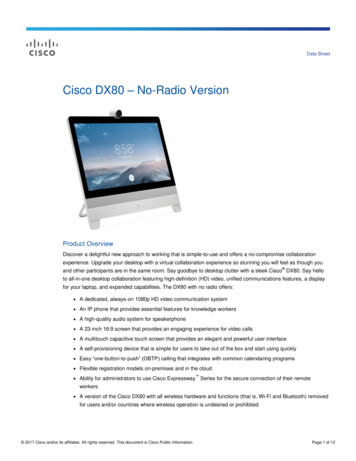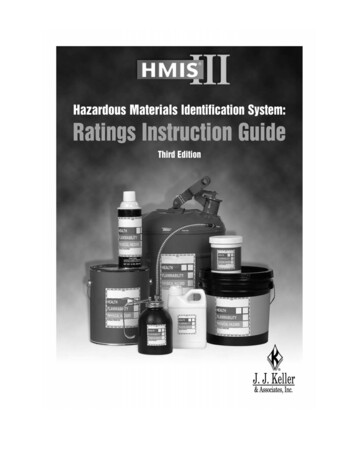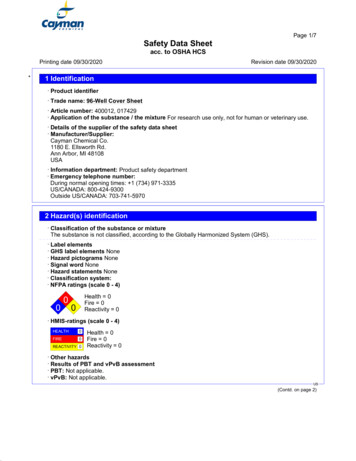
Transcription
Handbook for RCs and HCson Emergency Preparedness and Response
This handbook was developed by the Inter-Agency Standing Committee (IASC) HC Group.The IASC was established in 1992 in response to United Nations General AssemblyResolution 46/182 that called for strengthened coordination of humanitarian assistance.In 1993, the General Assembly, through Resolution 48/57, affirmed IASC’s role as theprimary mechanism for inter-agency coordination of humanitarian assistance. A broadrange of UN and non-UN humanitarian partners participate in this Standing Committee.This handbook can be downloaded from the IASC website at :http ://www.humanitarianinfo.org/iasc Inter-Agency Standing Committee (IASC) 2010.Cover page photos: UN Photo/Tim McKulkaSuggested citation :Inter-Agency Standing Committee (IASC) (2010). Handbook for RCs and HCs onEmergency Preparedness and Response. Geneva : IASC.This handbook and the checklist will be revised and updated on a regular basis. Feedbackand comments are therefore welcome, and should be sent to: hlsu@un.orgOCHA would like to express its gratitude for the financial support of the EuropeanCommission and its Humanitarian Aid and Civil Protection department (ECHO).Handbook for RCs and HCs on Emergency Preparedness and Response
Table of ContentsINTRODUCTIONInternational humanitarian coordination architectureGuiding principlesAccountabilitySupportI. DISASTER RISK REDUCTION1145571. Lead and coordinate efforts to strengthen country-level commitment toand capacities for disaster risk reduction7National Platform for Disaster Risk ReductionStrategic National Action Plan (SNAP) for Disaster Risk ReductionNational Matrix of Commitment and Initiatives in support of the HFA910112. Lead and coordinate inter-agency efforts in disaster risk reductionPool of Disaster Risk Reduction ExpertsCapacity for Disaster Reduction Initiative (CADRI)II. PREPAREDNESS121313151. Lead and coordinate efforts to strengthen national capacity to respondto emergencies15International instruments and guidelines to facilitate international relief162. Lead and coordinate inter-agency contingency planningCoordination structures for contingency planningInter-Agency Contingency PlanSecurity PlanCrisis Management Plan3. Lead and coordinate preparedness activitiesInter-Agency Simulation ExerciseEarly Warning-Early Action (EWEA) reportHandbook for RCs and HCs on Emergency Preparedness and Response1718182021222424
III. RESPONSE271. Define a preliminary scenario and alert all partnersGlobal Disaster and Alert Coordination System (GDACS)ReliefWebPreliminary scenario2. Ensure adequate response capacity in your officeUN Disaster Assessment and Coordination (UNDAC) TeamSurge capacity3. Establish and lead humanitarian coordination mechanismsHumanitarian Country Team (HCT)ClustersThematic groups on cross-cutting issuesEarly Recovery NetworkInter-cluster coordination mechanismSecurity Management Team (SMT)Crisis Management Team (CMT)4. Lead and coordinate multi-cluster needs luster rapid needs assessment49In-depth sectoral needs assessments and other inter-agency assessments 4949Coordinated situation monitoring5. Lead and coordinate inter-agency response planningHumanitarian response planProtection StrategyEarly Recovery Strategic Framework (ERSF)6. Lead and coordinate operational response activitiesInternational Humanitarian Partnership (IHP)Humanitarian Information Centre (HIC)Foreign Military and Civil Defence Assets (MCDA)On-Site Operations Coordination Centre (OSOCC)Virtual On-Site Operations Coordination Centre (VOSOCC)Urban Search and Rescue (USAR) teamsSituation report (SitRep)Partnerships with private sector actorsWho Does What Where (3W Database)OCHA stockpileSphere Minimum Standards in Disaster Response50515252535657575859596060616161Handbook for RCs and HCs on Emergency Preparedness and Response
7. Mobilize financial resourcesAppeal mechanismsFlash AppealConsolidated Appeal Process (CAP)Funding instrumentsOCHA Emergency Cash GrantUNDP Response to Sudden CrisisCentral Emergency Response Fund (CERF)Country-based Pooled Funds : Emergency Response Fund (ERF)Common Humanitarian Fund (CHF)Financial Tracking Service (FTS)8. Lead and coordinate inter-cluster monitoring and evaluationMonitoring toolsEvaluation toolsInter-Agency Real-Time Evaluation (IA RTE)Inter-Agency Joint Evaluation9. Facilitate humanitarian access626365676870747677787980808182International Humanitarian Law (IHL)International instruments and guidelines to facilitate international reliefGeneral Assembly Resolution 46/182Humanitarian principlesArmed or military escorts for humanitarian convoysNegotiation analysis and strategy84858686878810. Promote the respect of international humanitarian and human rights law91Domestic LawRegional InstrumentsInternational LawKey protection principlesAdvocacy strategies11. Lead and coordinate efforts against sexual exploitation and abuse939393959698Action plan on PSEA9912. Manage media relations101Do’s and don’ts when talking to the pressField Key MessagesMedia PlatformsUN Communications Group (UNCG)Handbook for RCs and HCs on Emergency Preparedness and Response103103103104
13. Lead and coordinate transition from response to recoverySurge capacity for transition to recoveryPost-Conflict Needs Assessment and Transitional Results Framework(PCNA-TRF)Post-Disaster Needs Assessment and Recovery Framework (PDNA-RF)Phase-down strategy for humanitarian operationsUN Integrated Strategic Framework (ISF)Peacebuilding Fund for Recovery (PBF)IV. CROSS-CUTTING ISSUESAgeDiversityEnvironmentGender equalityHIV-AIDSMental health and psychosocial supportV. 113113113114115116117119119122130Handbook for RCs and HCs on Emergency Preparedness and Response
Handbook for RCs and HCs on Emergency Preparedness and Response
introductionINTRODUCTION
About this handbookThis handbook outlines the key actions that Resident Coordinators (RCs) and HumanitarianCoordinators (HCs) should take to prepare for and respond to emergencies. It does notaim to replace more in-depth guidance or policy documents.Chapters are organized as follows :Chapter title Refers to a task that the RC or HC is accountable for.What is your role ? Summarizes the main actions that need to be taken to accomplishthe task.When and how ? Provides a more detailed time frame of the actions to be taken. Foradditional information on key concepts printed in blue, see the index.Remember ! Contains tips or important background information.Which tools, services or mechanisms to use ? Lists relevant tools, services andmechanisms at the RC’s or HC’s disposal to perform the necessary actions.Good to know Lists additional tools that are not for the RC or HC’s direct use butare useful to be aware of.Where to go for more information Lists key websites and reference document(s).Additional resources can be found in the annex.The Annex includes :AcronymsIndex Lists key concepts with a reference to the page(s) where they are explained.Resources Lists useful documents and websites for further reference.Contacts referred to in the handbook can be found in the back cover.International humanitarian coordination architectureThe foundations of the current international humanitarian coordination architecture werelaid by General Assembly Resolution 46/182 of December 1991. The HumanitarianReform of 2005 introduced a number of new elements to enhance predictability,accountability, and partnership.The Emergency Relief Coordinator (ERC) has three primary tasks : humanitarianpolicy development and coordination; advocacy of humanitarian issues and provision ofguidance and direction to RCs and HCs; and coordination of international humanitarianresponse.The Inter-Agency Standing Committee (IASC), chaired by the ERC, is an inter-agencyforum for coordination, policy development and decision-making involving the key UNand non-UN humanitarian partners, including United Nations agencies, the InternationalINTRODUCTION1
Red Cross and Red Crescent Movement, the International Organization for Migration,non-governmental organizations (NGOs), NGO consortia, and the World Bank.1Clusters, led and coordinated by Clusters Lead Agencies, are IASC-designatedgroupings of humanitarian organizations (both UN and non-UN) in each of the mainsectors of humanitarian action. They operate at both global and country level (althoughthey are not necessarily congruent). At the global level they are responsible forstrengthening system-wide preparedness and coordinating technical capacity to respondto humanitarian emergencies in their respective sector. At the country level clustersensure that activities of humanitarian organizations are coordinated, serve as a first pointof call for the Government and the RC or HC, and as a provider of last resort in theirrespective sector.The Office for the Coordination of Humanitarian Affairs (OCHA), headed by theERC, is a Department of the UN Secretariat that supports the ERC at the global leveland RCs and HCs at the field level by coordinating humanitarian action, advocating forthe rights of people in need, developing humanitarian policy and analysis, managinghumanitarian information systems, and managing humanitarian pooled funds. OCHAtypically supports HCs through a Country Office and RCs through its Regional Offices,and in some cases through a Humanitarian Support Unit in country.At country level, while the primary responsibility for coordinating humanitarian assistancerests with national authorities, if international humanitarian assistance is required the HC– or, if a separate HC position is not established, the RC – is responsible for leading andcoordinating the preparedness and response efforts of humanitarian organizations (bothUN and non-UN), whenever possible in support of and in coordination with national andlocal authorities. The ERC may choose to designate the RC as HC, in consultation with theIASC, if the situation so requires.The Humanitarian Country Team (HCT), chaired by the RC or HC, is an operationaldecision-making forum composed of operationally relevant humanitarian organizations(both UN and non-UN) and focusing on common strategic and policy issues related tohumanitarian action in country.12IASC Members are FAO OCHA, UNDP, UNFPA, UNHABITAT, UNHCR, UNICEF, WFP and WHO. IASC Standinginvitees are ICRC, ICVA, IFRC, InterAction, IOM, OHCHR, RSG on Human Rights of IDPs, SCHR and the WorldBank.Handbook for RCs and HCs on Emergency Preparedness and Response
INTRODUCTION3NGONGOAgency ter coordinationReportingCoordinationNGOs CountryRepresentativeHumanitarianCountry TeamNGONGOConsortia** The Agency Country Representative reports to his/heragency on agency responsibilities and to the RC or HC oncluster responsibilities.* If a separate HC position is not berClustermemberClustermemberCluster CoordinatorAgency CountryRepresentative /Head of Cluster LeadAgency **ClusterOCHAHC or RC*Agency stermemberClustermemberCluster henever possible theHCT and the clusterscomplement andsupport national/localcoordination structures.Global ClusterCoordinatorAgency CountryRepresentative /Head of Cluster LeadAgency **ClusterAgency HeadGlobal ClusterAgency Head / Head ofGlobal Cluster LeadAgencyIASC Humanitarian Coordination Architecture
Guiding principlesIn discharging their duties, RCs and HCs should be guided by the following principles :1 Support the GovernmentEach State has the responsibility first and foremost to take care of the victims ofemergencies occurring on its territory by initiating, organizing, coordinating andimplementing humanitarian assistance.2The RC or HC should support national efforts by leading and coordinating humanitarianaction of relevant organizations in country, whenever possible in support of and incoordination with national and local authorities. 32 Be guided by international humanitarian and human rights law andhumanitarian principlesIn all activities, the RC or HC should be guided by international humanitarian and humanrights law as well as by the humanitarian principles.4 These are :–– Humanity : Human suffering must be addressed wherever it is found. The purpose ofhumanitarian action is to protect life and health, and to ensure respect for the humanbeing.–– Impartiality : Humanitarian action must be carried out on the basis of humanitarianneed alone, giving priority to the most urgent cases of distress and making nodistinctions on the basis of nationality, race, religious beliefs, class or political opinions.–– Neutrality : Humanitarian actors must not take sides in hostilities or engage incontroversies of a political, racial, religious or ideological nature.–– Independence : Humanitarian action must be autonomous from political, economic,military or other objectives that any actor may hold regarding areas where humanitarianaction is being implemented.3 Be guided by the Principles of PartnershipRelations among organizations involved in humanitarian action are governed by thePrinciples of Partnership (PoP) 5 :Equality : Equality requires mutual respect among members of the partnershipirrespective of size and power.23454See UN General Assembly Resolution 46/182 of 19 December 1991.See the Terms of Reference of the Humanitarian Coordinator, IASC, 2009 and the UN Resident CoordinatorGeneric Job Description, UNDG, 2009.See the Terms of Reference of the Humanitarian Coordinator, IASC, 2009 and the UN Resident CoordinatorGeneric Job Description, UNDG, 2009.Endorsed by the Global Humanitarian Platform, 12 July 2007.Handbook for RCs and HCs on Emergency Preparedness and Response
Transparency : Transparency is achieved through dialogue (on equal footing), with anemphasis on early consultations and early sharing of information.Result-oriented approach : Effective humanitarian action must be reality based andaction oriented.Responsibility : Humanitarian organizations have an ethical obligation to each other toaccomplish their tasks responsibly, with integrity and in a relevant and appropriate way.Complementarity : The humanitarian community’s diversity is an asset if we build onour comparative advantages and complement each others’ contributions.AccountabilityThe HC is ultimately accountable to the populations in need. S/he reports directly to theEmergency Relief Coordinator (ERC).6If international humanitarian assistance is required and a separate HC position is notestablished, the RC is accountable to the ERC for the performance of humanitariancoordination functions. 7SupportIf you are a HC, your first port of call is the OCHA Country Office, if one exists. If there isno OCHA presence in your country, contact the OCHA Regional Office.If you are an RC, your first port of call is the OCHA Regional Office covering your country.At headquarters level, your entry point is the head of the OCHA’s Coordination andResponse Division, based in New York.For urgent support needs, contact the OCHA Emergency Relief Coordination Centre,based in Geneva, which operates 24/7 ( 41 22 917 2010).67See the Terms of Reference of the Humanitarian Coordinator, IASC, 2009.See the UN Resident Coordinator Generic Job Description, UNDG, 2009.INTRODUCTION5
Handbook for RCs and HCs on Emergency Preparedness and Response
DISASTER RISK REDUCTIONDISASTER RISK REDUCTION
1. Lead and coordinate efforts to strengthen country-levelcommitment to and capacities for disaster risk reductionWhat is your role ?–– Advocate with the Government for the integration of disaster risk reduction in nationalpolicies, planning and programming.–– Support the Government in strengthening national capacity for disaster risk reduction.–– Advocate with key actors to raise awareness on social responsibilities for disaster riskreduction.When and how ?Promote and support the development of a multi-stakeholder NationalPlatform for Disaster Risk Reduction to support the development andimplementation of a Strategic National Action Plan.Encourage the Government to develop a Strategic National ActionPlan (SNAP) for Disaster Risk Reduction through multi-disciplinaryconsultations at the national level.At all timesEncourage UNCT members and other relevant stakeholders to facilitate andsupport the SNAP process, and to align the UNDAF and individual agencies’country strategies with it.Support the National Platform for Disaster Risk Reduction in conductinga mapping exercise leading to the creation of a National Matrix ofCommitment and Initiatives in Disaster Risk Reduction.Advocate with the Government on the need to incorporate disaster riskreduction in sustainable development policies, planning and programming(e.g. PRSP, environmental and natural resource management) at all levels(e.g. National Development Plans, sector strategies, private sector plans andbudgetary allocations).a If necessary, mobilize support from relevant UN agencies to assist theGovernment in this process.Advocate with local authorities (including municipalities, national andsectoral planning agencies), civil society, academic and technical institutionsand the private sector for the establishment of mechanisms to manage risksin the country, and for the development of a culture of social responsibilitywith respect to risk reduction.DISASTER RISK REDUCTION7
At all timesEncourage national and local authorities to increase collaboration betweenclimate change and environmental bodies and experts, and their disaster riskreduction counterparts (e.g. by including climate change and environmentalexperts in the National Platform for Disaster Risk Reduction).Encourage them to adopt a common agenda for climate change adaptation.Support the Government’s resource mobilization efforts for disaster riskreduction by :Creating a framework for coordinating UN, non-UN and donor contributions.Facilitating interactions among disaster risk reduction stakeholders (UNCTmembers, international financial institutions, regional organizations, NGOs,civil society and bilateral donors).Identifying specific areas where donors can support national priorities.Encourage all stakeholders (including the Government) to use agreed-uponindicators to measure the reduction of disaster risks and the progress onthe implementation of the goals and priorities of the Hyogo Framework forAction (HFA).Encourage the Government to :Develop its HFA progress report.Include disaster risk reduction in intergovernmental and national reports.If necessary, mobilize support from relevant UN agencies to assist theGovernment in this respect.Under Government leadership and in consultation with the UNCT, defineappropriate measures for regular assessment of progress toward achievingthe goals and priorities of the HFA. Ensure joint monitoring and assessmentof agreed commitments.Remember !A total of 168 countries committed to address disaster risk reduction under the overallframework of the HFA and to regularly report on their progress through the onlineHFA monitor. The analysis of information uploaded on this monitor is periodicallydocumented through a Global Assessment Report on Disaster Risk Reduction.The Global Platform on Disaster Reduction, which takes place every two years,provides a good opportunity for countries to demonstrate their achievements onHFA implementation.The International Day for Disaster Reduction (second Wednesday of October) is agood opportunity to mobilize the Government, communities and individuals throughawareness campaigns and special activities.8Handbook for RCs and HCs on Emergency Preparedness and Response
Which tools, services and mechanisms to use ?1 National Platform for Disaster Risk Reduction2 Strategic National Action Plan (SNAP) for Disaster Risk Reduction3 National Matrix of Commitment and Initiatives in support of the HFA1 National Platform for Disaster Risk ReductionWhat is it ?A nationally owned and led forum of stakeholders involved in disaster risk reduction thatserves as the national coordination mechanism for disaster risk reduction. The platformshould build on existing Government disaster management or development planningcoordination mechanisms. Activities are typically coordinated by a national coordinationstructure (under the auspices of HFA national focal point) in close consultation with theRC and the UNCT.Through the platform, a single forum coordinates and supports all relevant stakeholdersat the national level, and coordinates their commitment to implementing disaster riskreduction programmes and policies within the context of each country’s existing capacitybuilding efforts and governance arrangements.What is its purpose ?To help strengthen the Government’s disaster risk reduction efforts by :-- Ensuring a more inclusive and participatory approach.-- Helping develop a culture of safety and resilience.-- Advocating for disaster risk reduction, particularly for its integration intodevelopment policies, strategies and activities, as well as into multilateralenvironmental and climate change agreements.Who participates in it ?Stakeholders involved in disaster risk reduction from a wide range of disciplines suchas Government representatives from national, state/provincial and local levels (includingministries); representatives of civil society; the media; technical and scientific (academic)institutions; UNCT members; the donor community; and the private sector.DISASTER RISK REDUCTION9
Remember !Disaster risk reduction is a multisectoral endeavour requiring the participation of awide range of national stakeholders, hence the added value of establishing a NationalPlatform.Ideally, the institution coordinating the National Platform should be a permanentstructure of sufficiently high calibre with a national coordination mandate in disasterrisk reduction.The National Platform should be aligned with Government structures for environmentand climate change to ensure a common agenda.Where to go for more information ?Guidelines on National Platforms for Disaster Risk Reduction, ISDR, 2007.2 Strategic National Action Plan (SNAP) for Disaster Risk ReductionWhat is it ?A long-term multisectoral and multi-stakeholder planning instrument that identifies acountry’s disaster risk reduction and disaster management priorities, including climatechange adaptation measures, in line with the Hyogo Framework for Action and inaccordance with the country’s capacities.Who participates in it ?The planning process should be led by the Government, through the National Platformand with support from development partners including the UNCT.Remember !The SNAP is owned, led and approved by the Government which is responsible for itsdesign and implementation. The SNAP should be fully aligned with existing nationalplanning processes.The SNAP should be aligned with national efforts to address climate changeadaptation.Prior to developing a SNAP, a series of extensive fact-finding consultations identifynational priorities to be supported by donors and UN agencies. This provides thebasis for all relevant stakeholders in-country to participate, develop and approveresources to support and implement the SNAP.10Handbook for RCs and HCs on Emergency Preparedness and Response
3 National Matrix of Commitment and Initiatives in support of the HFAThis matrix maps out how international development and humanitarian partners,including UN agencies, will support Government efforts for disaster risk reduction byoutlining specific programmes, resources and capacities of partners.DISASTER RISK REDUCTION11
2. Lead and coordinate inter-agency efforts in disaster riskreductionWhat is your role ?–– Lead the UNCT in integrating disaster risk reduction into UN planning and programmingtools.–– Encourage the adoption of a common agenda for disaster risk reduction and climatechange adaptation.–– Coordinate the UN system’s operational activities for disaster risk reduction at thecountry level.–– Develop an advocacy strategy and raise awareness for disaster risk reduction.As soon aspossibleWhen and how ?In consultation with the UNCT, establish a shared understanding of thedisaster risk reduction country context. In the absence of national analysis,facilitate and coordinate a UNCT analytical process in the context of theCCA. Use other analytical frameworks, such as poverty reduction strategies,to identify existing disaster risks.Lead the process for integrating disaster risk reduction into UN planningand programming tools (UNDAF), clearly defining the contributions of UNpartners to national development goals and priorities.a If the country faces a specific disaster risk, consider establishing an UNDAFsub-group for that risk.At all timesCoordinate the UN system’s operational activities for disaster risk reductionat the country level. Promote coherence of strategies and programmes forachieving the goals of the Hyogo Framework for Action.Promote the coordination of UNCT work on disaster risk reduction andclimate change, particularly if the primary disaster risk in your country isrelated to climate change.Ensure that progress toward goals and priorities in DRR is included in existingUN reports, such as the annual UNCT reports.With the UNCT, develop an advocacy strategy in DRR.Promote and support the development of education programmes, trainingworkshops and awareness-raising campaigns on specific disaster riskreduction aspects, and support national participation in international trainingopportunities.12Handbook for RCs and HCs on Emergency Preparedness and Response
Remember !UN initiatives should complement one another and respond to the country’srequirements for disaster risk reduction contained in the UNDAF.It is important to promote linkages between disaster risk reduction and the MDGs.When preparing the UNDAF, facilitate Government ownership in identifying nationaldisaster risk reduction challenges and in suggesting policy options for addressingroot causes.An advocacy strategy in DRR should :-- Identify disaster risk reduction issues on which to raise awareness, such ascurrent national priorities.-- Identify which messages and actions will have the highest impact.-- Identify partners for the activities (including by providing resources).-- Identify target groups for messages and activities.Which tools and services to use ?1 Pool of Disaster Risk Reduction ExpertsUNDG has set up an inter-agency pool of disaster risk reduction experts to provide trainingand technical support to UNCTs throughout the UNDAF process. Contact the RegionalUNDG team (formerly known as Regional Directors Teams, RDTs) to request an expert.82 Capacity for Disaster Reduction Initiative (CADRI)CADRI is a partnership of OCHA, UNDP/BCPR and UNISDR. It provides support to RCsand agencies involved in DRR for in-country development of national capacities.Contact CADRI directly in Geneva, or through any of the three partner organizations atcountry/regional level.Good to know1 The biennial World Campaign on Disaster ReductionLed by UNISDR, it provides Governments, UNCTs, National Platforms and other interestednational and local actors with awareness-raising activities and tools on disaster riskreduction.8For contact detail, see http ://www.undg.org/index.cfm ?P 684DISASTER RISK REDUCTION13
Where to go for more information ?Disaster Risk Reduction in the United Nations : Roles, Mandates and Areas of Work of KeyUnited Nations Entities, ISDR, 2009.Integrating Disaster Risk Reduction into the CCA/UNDAF – A Guide for UN CountryTeams, UNDG, 2009.14Handbook for RCs and HCs on Emergency Preparedness and Response
preparednesspreparedness
1. Lead and coordinate efforts to strengthen nationalcapacity to respond to emergenciesWhat is your role ?–– Lead and coordinate inter-agency efforts to strengthen national capacity to respondto emergencies.–– Advocate with the Government to increase funding for response preparedness.As soon as possibleWhen and how ?Review with the Government national efforts for preparedness, includingexisting national preparedness plans. Lead and coordinate inter-agencyefforts to carry out a multisectoral assessment of the Government’s capacityto respond. Based on the result, coordinate inter-agency efforts to strengthenGovernment’s capacity-to respond to emergencies.Familiarize yourself with existing national legislation for disaster relief andwith international legal instruments to facilitate international reliefadhered to by the country. If some areas are not covered, advocate with theGovernment to :–– Ratify international legal instruments to fill these gaps.At all times–– Sign a Model Customs Agreement with the UN to facilitatecustoms clearance and licensing of emergency relief items.–– Develop national legislation to facilitate international relief using theGuidelines for the Domestic Facilitation and Regulation ofInternational Disaster Relief and Initial Recovery Assistance asa model.Advocate with the Government to develop policies and procedures forrequesting and receiving international assistance if needed during anemergency, using the Guidelines for the Domestic Facilitation and Regulationof International Disaster Relief and Initial Recovery Assistance as a model.Advocate with the Government to increase funding for responsepreparedness. For example by setting a target on resources to be allocatedfor preparedness activities, particularly at national and community levels.PREPAREDNESS15
Which tools and services to use ?International instruments and guidelines to facilitate international relief Guidelines for the Domestic Facilitation and Regulation of InternationalDisaster Relief and Initial Recovery Assistance (2007). These non-bindingguidelines were developed by the IFRC and adopted by the State parties to theGeneva Con
Handbook for RCs and HCs on Emergency Preparedness and Response 2 Red Cross and Red Crescent Movement, the International Organization for Migration, non-governmental organizations (NGOs), NGO consortia, and the World Bank.1 Clusters, led and c










